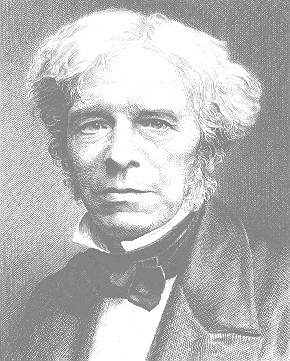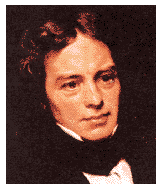Michael Faraday
Faraday, Michael (1791-1867)
 English bookbinder who
became interested in Electricity. He
obtained an assistantship in Davy's lab, then
began to conduct his own experiments. He wrote a
review article on current views about Electricity and Magnetism in 1821, for which he
reproduced Oersted's experiment.
He was one of the greatest experimenters ever.
Because he was self trained, however, he had no
grasp of mathematics and could therefore not
understand a word of Ampère's papers. In
the course of his experiments, Faraday discovered
that a suspended magnet would revolve around a
current bearing wire, leading him to propose that
magnetism was a circular force. He also
discovered magnetic optical rotation, invented
the Dynamo (a device capable of
converting electricity to motion) in 1821,
discovered electromagnetic induction in 1831, and
devised the laws of chemical electro-deposition
of metals from solutions in 1857. English bookbinder who
became interested in Electricity. He
obtained an assistantship in Davy's lab, then
began to conduct his own experiments. He wrote a
review article on current views about Electricity and Magnetism in 1821, for which he
reproduced Oersted's experiment.
He was one of the greatest experimenters ever.
Because he was self trained, however, he had no
grasp of mathematics and could therefore not
understand a word of Ampère's papers. In
the course of his experiments, Faraday discovered
that a suspended magnet would revolve around a
current bearing wire, leading him to propose that
magnetism was a circular force. He also
discovered magnetic optical rotation, invented
the Dynamo (a device capable of
converting electricity to motion) in 1821,
discovered electromagnetic induction in 1831, and
devised the laws of chemical electro-deposition
of metals from solutions in 1857.
http://www.treasure-troves.com/bios/Faraday.html
Michael Faraday (1791-1867)
 Michael Faraday was born on
22nd September 1791. At the age of fourteen he
was apprenticed to a London bookbinder. Reading
many of the books in the shop, Faraday became
fascinated by science, and wrote to Sir Humphry
Davy at the Royal Institution asking for a job.
On 1st March 1813, he was appointed laboratory
assistant at the Royal Institution. There Faraday
immersed himself in the study of chemistry,
becoming a skilled analytical chemist. In 1823 he
discovered that chlorine could be liquefied and
in 1825 he discovered a new substance known today
as benzene. Michael Faraday was born on
22nd September 1791. At the age of fourteen he
was apprenticed to a London bookbinder. Reading
many of the books in the shop, Faraday became
fascinated by science, and wrote to Sir Humphry
Davy at the Royal Institution asking for a job.
On 1st March 1813, he was appointed laboratory
assistant at the Royal Institution. There Faraday
immersed himself in the study of chemistry,
becoming a skilled analytical chemist. In 1823 he
discovered that chlorine could be liquefied and
in 1825 he discovered a new substance known today
as benzene.
However, his greatest work was with electricity.
In 1821, soon after the Danish chemist, Oersted,
discovered the phenomenon of electromagnetism,
Faraday built two devices to produce what he
called electromagnetic rotation: that is a
continuous circular motion from the circular
magnetic force around a wire. Ten years later, in
1831, he began his great series of experiments in
which he discovered electromagnetic induction.
These experiments form the basis of modern
electromagnetic technology.
Faraday's descriptive theory of lines of force
moving between bodies with electrical and
magnetic properties enabled James Clerk Maxwell
to formulate an exact mathematical theory of the
propagation of electromagnetic waves.
In 1865, Faraday ended his connection with the
Royal Institution after over 50 years of service.
He died at his house at Hampton Court on 25th
August 1867.
http://www.iee.org.uk/publish/faraday/faraday1.html
Der zweiseitige Ruhm des Michael Faraday
Michael Faraday (1791-1867) gilt als
der hervorragende Experimentator seiner Zeit.
Durch seine Experimente hat er bedeutsame
Beziehungen zwischen den elektrischen und
magnetischen Erscheinungen praktisch erkannt und
formuliert. Faraday wird gelegentlich in etwas
überschwenglicher Art als Totengräber der
klassischen Elektrizitätslehre und Begründer
der modernen physikalischen Auffassungen
bezeichnet. Was hat Faraday eigentlich selbst
gewollt, und was haben seine Nachfolger daraus
gemacht?
http://www.miriup.de/spur/4.9.html
ESVA: Faraday Mini-Exhibit
"The world little knows how
many of the thoughts and theories which have
passed through the mind of the scientific
investigator have been crushed in silence and
secrecy by his own severe criticism and adverse
examination; that in the most successful
instances not a tenth of the suggestions, the
hopes, the wishes, the preliminary conclusions
have been realized."
--Michael Faraday
http://www.aip.org/history/esva/exhibits/fara.htm
Michael Faraday -- Super Scientist
Biography
Michael Faraday (1791 - 1867). Born
to a poor family in London, he was extremely
curious, questioning everything. He felt an
urgent need to know more. At age 13, he became an
errand boy for a bookbinding shop in London. He
read every book that he bound, and decided that
one day he would write a book of his own. He
became interested in the concept of energy, or
more specifically, force. Because of his early
reading and experiments with the idea of force,
he was able to make important discoveries in
electricity later in life. He eventually became a
chemist and physicist. He isolated benzene (a
clear, colorless, flammable liquid derived from
petroleum and used to manufacture motor fuels).
He performed experiments demonstrating discovery
of electromagnetic induction. This discovery
paved the way for changing mechanical energy into
electrical energy.
http://www.energy.ca.gov/education/scientists/faraday.html
MICHAEL FARADAY
Michael Faraday, the discoverer of
electro-magnetic induction, electro-magnetic
rotations, the magneto-optical effect,
diamagnetism, field theory and much else besides,
was born in Newington Butts (the area of London
now known as the Elephant and Castle) on 22
September 1791.
http://www.ri.ac.uk/History/M.Faraday/
MICHAEL FARADAY
FARADAY : CHEMIST,
PHYSICIST, NATURAL PHILOSOPHER
This report of the famous scientist
Michael Faraday is composed principally of the
transcriptions of two interviews with Faraday,
hitherto unpublished. The contents of the
interviews indicate they were both with Faraday
while he was the Director of the Laboratory at
the Royal Institute, in London.
http://www.woodrow.org/teachers/ci/1992/Faraday.html
Michael Faraday
Linksammlung über Michael Faraday
und seine wissenschaftliche Arbeit.
http://www.jteln.de/privat/p_niester/p_natwis/michael_faraday/
Michael Faraday
'My education was of the most
ordinary description, consisting of little more
than the rudiments of reading writing and writing
at a common day school.
My hours out of school were passed at home or on
the streets.'
Michael Faraday
http://www.tales.ndirect.co.uk/FARADAY1.HTML
Faraday Laboratory & Museum
The Michael Faraday Museum
houses his apparatus, manuscripts, pictures and
personal memorabilia which include his medals,
watches, microsopes and an inkstead. His Magnetic
Laboratory has been restored on its original
site. Among his many discoveries are the
principles of electric motor, the transformer and
the dynamo - the basis of electrical power and
other electrical engineering industries. The
instruments which he made or commissioned are on
display, as well as the first sample of Benzene
which he discovered, and the apparatus used in
his pioneering work on the liquifaction of gases.
http://www.ri.ac.uk/History/MFL&M.html
Michael Faraday (1791-1867) &
Creative Quotations
The lecturer should give the
audience full reason to believe that all his
powers have been exerted for their pleasure and
instruction. Michael
Faraday
http://www.bemorecreative.com/one/907.htm
Michael Faraday
 Faraday was
born on September 22, 1791, in Newington, Surrey,
England. Faraday is famous mainly for his
contributions to the understanding of the link
between magnetism and electricity and for
establishing the quantitative laws of
electrolysis. He was the son of a blacksmith and
received little formal education. At the age of
14 he was apprenticed to a bookbinder in London,
where he was encouraged to read books on
scientific subjects and experiment with
electricity. In 1812 after attending a series of
lectures given by Sir Humphry Davy the British
chemist, he forwarded a request for employment.
Davy employed Faraday as an assistant in his
laboratory at the Royal Institute in 1813. Quite
soon after his appointment Faraday accompanied
Davy on a grand tour of Europe where he had the
unique opportunity of seeing scientific research
and attend lectures of some of Europe's finest
scholars. Faraday was
born on September 22, 1791, in Newington, Surrey,
England. Faraday is famous mainly for his
contributions to the understanding of the link
between magnetism and electricity and for
establishing the quantitative laws of
electrolysis. He was the son of a blacksmith and
received little formal education. At the age of
14 he was apprenticed to a bookbinder in London,
where he was encouraged to read books on
scientific subjects and experiment with
electricity. In 1812 after attending a series of
lectures given by Sir Humphry Davy the British
chemist, he forwarded a request for employment.
Davy employed Faraday as an assistant in his
laboratory at the Royal Institute in 1813. Quite
soon after his appointment Faraday accompanied
Davy on a grand tour of Europe where he had the
unique opportunity of seeing scientific research
and attend lectures of some of Europe's finest
scholars.
http://www.the-education-site.com/faraday.html
The 1827 Christmas Lectures of Michael
Faraday
A Project of the 1992 Summer
Institute of the Woodrow Wilson Leadership
Program in Chemistry.
http://www.woodrow.org/teachers/ci/faraday/
|



